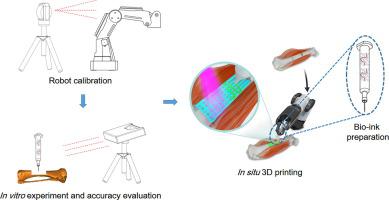Journal of Advanced Research ( IF 11.4 ) Pub Date : 2020-11-25 , DOI: 10.1016/j.jare.2020.11.011 Lan Li 1, 2, 3 , Jianping Shi 1, 4 , Kaiwei Ma 2 , Jing Jin 1 , Peng Wang 1, 3 , Huixin Liang 1, 3 , Yi Cao 5 , Xingsong Wang 2 , Qing Jiang 1, 3

|
Introduction
The traditional clinical treatment of long segmental bone defects usually requires multiple operations and depends on donor availability. The 3D bio-printing technology constitutes a great potential therapeutic tool for such an injury. However, in situ 3D bio-printing remains a major challenge.
Objectives
In this study, we report the repair of long segmental bone defects by in situ 3D bio-printing using a robotic manipulator 3D printer in a swine model.
Methods
We systematically optimized bio-ink gelation under physiological conditions to achieve desirable mechanical properties suitable for bone regeneration, and a D-H kinematic model was used to improve printing accuracy to 0.5 mm.
Results
These technical improvements allowed the repair of long segmental defects generated on the right tibia of pigs using 3D bio-printing within 12 min. The 3D bio-printing group showed improved treatment effects after 3 months.
Conclusion
These findings indicated that robotic in situ 3D bio-printing is promising for direct clinical application.
中文翻译:

机器人原位3D生物打印技术修复大节段骨缺损
介绍
长节段性骨缺损的传统临床治疗通常需要多次手术并取决于供体的可用性。3D 生物打印技术构成了这种损伤的巨大潜在治疗工具。然而,原位3D 生物打印仍然是一个重大挑战。
目标
在这项研究中,我们报告了使用机器人机械手 3D 打印机在猪模型中通过原位3D 生物打印修复长节段骨缺损。
方法
我们系统地优化了生理条件下生物墨水的凝胶化,以实现适合骨再生的理想机械性能,并使用 DH 运动学模型将打印精度提高到 0.5 毫米。
结果
这些技术改进允许使用 3D 生物打印在 12 分钟内修复猪右胫骨上产生的长节段缺陷。3D 生物打印组在 3 个月后显示出改善的治疗效果。
结论
这些发现表明机器人原位3D 生物打印有望直接应用于临床。











































 京公网安备 11010802027423号
京公网安备 11010802027423号